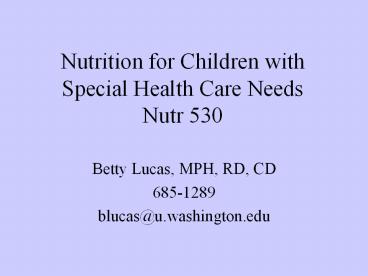Nutrition for Children with Special Health Care Needs Nutr 530 - PowerPoint PPT Presentation
Title:
Nutrition for Children with Special Health Care Needs Nutr 530
Description:
Risk Factors; Etiologies ... Unknown etiology. Why are these children at higher risk for nutrition concerns? ... of Unknown Etiology: Cornelia DeLange syndrome ... – PowerPoint PPT presentation
Number of Views:315
Avg rating:3.0/5.0
Title: Nutrition for Children with Special Health Care Needs Nutr 530
1
Nutrition for Children with Special Health Care
NeedsNutr 530
- Betty Lucas, MPH, RD, CD
- 685-1289
- blucas_at_u.washington.edu
2
Who are CSHCN?
- Those who have or are at increased risk for a
chronic physical, developmental, behavioral, or
emotional condition, and who also require health
and related services of a type or amount beyond
that required by children generally - McPherson M et al. A new definition of children
with special health care needs. Pediatrics, 1998.
3
CSHCN includes
- Birth defects
- Result of trauma
- Cancer
- Perinatal drug exposure
- Infection sequelae, e.g. CMID, meningitis
4
Who are Children at Increased Risk?
- Very low birth weight
- Metabolic deficiencies
- Some chromosomal abnormalities
- Extreme poverty
- Absence of social support
- Child abuse or neglect
- Air pollution, 2nd-hand smoke and infestations
that can exacerbate conditions such as asthma
5
Required Health and Related Services are
- Specialized medical nursing services enhanced
preventive and primary services - Therapies such as PT, OT, speech, mental health,
home health, nursing services - Family support services, e.g. counseling, case
management, care coordination, respite care - Durable medical equipment and assistive devices
- Early intervention (birth-3 yrs, special
education, transportation, social services
6
(No Transcript)
7
Developmental Disability
- A chronic severe disability of a person 5 yrs and
older which - -is attributable to a mental or physical
impairment or combination - - is manifested before age 22 yrs
- - is likely to continue indefinitely
- (Public Law No. 101-496, Developmental
Disabilities Assistance and Bill of Rights Act of
1990)
8
DD cont.
- Results in substantial functional limitations in
3 or more of these areas of major life activity - -self care - receptive/expressive language
- - learning - mobility
- - self-direction - capacity for independent
living - - economic sufficiency
9
(No Transcript)
10
DD - cont
- Reflects the persons need for a combination and
sequence of special, interdisciplinary, or
generic care, treatment, or other services which
are of lifelong or extended duration and are
individually planned and coordinated - Includes infants and children lt9 yrs, even
without delays in 3 areas, if they are likely to
meet the criteria later in life
11
(No Transcript)
12
Prevalence
- 17 of children lt18 yrs have some type of
developmental disability (CDC, 2001) - 79-90 of children under age 3 yrs with
developmental delays in early intervention (EI)
programs had 1 or more nutrition risk factors
(Bayerl et al., 1993) - 3-4 million Americans have DD, and another 3
million have milder forms of cognitive
disabilities or mental retardation
13
CSHCN in WA State
- 21 with mild condition
- 9 with moderate condition
- 2 with severe condition
- 68 well children
- 1993 census data, Newacheck
14
Risk Factors Etiologies
- Increased survival of premature and low
birthweight infants with subsequent sequelae,
i.e. cerebral palsy, MR, developmental delays,
learning/school difficulties - Genetic disorders
- Inherited metabolic disorders
- Chromosomal abnormalities specific syndromes
15
Risk Factors Etiologies
- Congenital anomalies disorders of organ systems
(cardiac, renal) - Exposure to alcohol, drugs, and related
substances - Poor prenatal care
- ?? Unknown etiology
16
Why are these children at higher risk for
nutrition concerns?
- Altered growth short stature, growth
retardation - Increased or decreased energy needs due to
medical condition, limited mobility - Overweight, underweight, FTT
- Inadequate nutrient intake due to feeding
difficulties, anorexia, increased needs
17
Why are these children at higher risk for
nutrition concerns?
- Feeding problems oral motor, self-feeding,
behavioral - Medication-nutrient interactions
- Special diets, e.g. renal, diabetic, PKU
- Disrupted parent-child feeding interactions
- Dental issues impacting feeding/diet
- Use of alternative and complementary therapies
18
Altered Growth
- Variations
- need to determine if normal or unusual pattern of
growth - Primary prenatal onset
- Secondary prenatal onset
- Postnatal onset
19
Primary Prenatal Onset
- Genetic
- inborn errors of metabolism
- Laurence-Moon-Biedel syndrome
- Chromosomal
- Prader-Willi
- Trisomies (Down syndrome)
- Turner syndrome
20
Primary Prenatal Onset
- Syndromes of Unknown Etiology
- Cornelia DeLange syndrome
- Williams syndrome
- Noonan syndrome
- Smith Lemli-Opitz syndrome
- Rubinstein-Taybi syndrome
21
Secondary Prenatal Onset
- Maternal factors
- smoking, alcohol, drugs (legal and illicit)
- infection (congenital rubella, herpes, syphilis)
- placental insufficiency
- poor maternal nutrition
- uncontrolled maternal disorder such as PKU
22
Postnatal Onset
- asphyxia (birth trauma, meconium aspiration,
etc.) - infection/sepsis
- prolonged hypoglycemia or acidosis
- IVH
- kernicterus
- deprivation
23
Services for CSHCN should be
- Comprehensive
- Coordinated
- Culturally-appropriate
- Community-based
- Family-centered
- (a challenge with limited resources and service
)
24
National Agenda for CSHCN
- All children will receive regular ongoing
comprehensive care within a medical home - All families will have adequate private and/or
public insurance to pay for needed services - All children will be screened early and
continuously for special health care needs
25
National Agenda for CSHCN
- Services for CSHCN and their families will be
organized in ways that families can use them
easily - Families of CSHCN will participate in decision
making at all levels and will be satisfied with
the services they receive - All youth with special health care needs will
receive the services necessary to make
appropriate transitions to all aspects of adult
life including adult health care, work
independence































